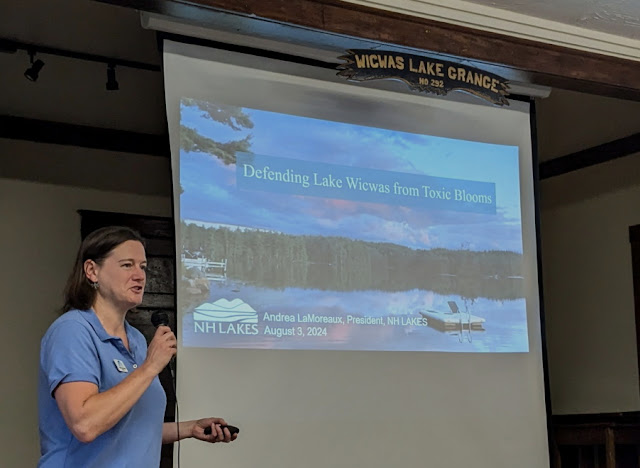We're getting towards the best time of the year to be outside: The bugs are mostly gone, the air is cooler and drier, and once the smoke from wildfires moves out the sky will be blue. With so many great hiking options right close by there's no need to travel far to get your nature fix. Right here beside Lake Wicwas is the 700 acre Hamlin-Eames-Smyth Town Forest with almost 20 miles of trails. One of my favorite loops is the Blue Trail that goes out to Double-dammed Pond.
 |
| Double-dammed Pond |
This pretty beaver pond got its name from the fact it has dams at both ends of its elongated pond. On my way out there I stopped to peruse numerous fungi with a range of sizes, colors, and shapes.
 |
| Indian Pipe |
 |
| Amanita |
 |
| Yellow Slime Mold |
Those are just a few of many you'll see if you take a walk in the woods this week. I'll include more of the mushrooms I've seen this summer when I do the annual fungus post.
🍄
Most of the woodland flowers are done blooming now but if you look along the shores of any pond or stream where more sun reaches the ground you're likely so see aquatic or wetland flowers blooming. A perennial late-summer favorite of mine is the turtlehead.
 |
| Turtlehead (Chelone glabra) |
It was on a walk to a different beaver pond quite a bit farther north that I came upon a fabulous raptor perched proudly on a drowned tree in the pond.
It was a small a raptor and I knew it was something special, though I wasn't prepared to declare it was a Merlin until I returned home and checked the field guides, and finally sent the picture to a friend who's a true avian expert (thanks RB!) and he confirmed it was a Merlin.
That's a first for me. I've seen small, fast raptors speeding through the yard on occasion and wondered if was a Merlin but never got a good enough look to know. To see one perched, waiting for an unsuspecting bird to fly near was a real treat. Merlins are small falcons and are very fast and powerful birds. Other birds are their primary food source; they catch them on the wing, chasing them down, or forcing them to fly higher until they tire out and are overtaken. Merlins breed in Canada so this one was probably on its way to the southern US or Central America for the winter.
 |
| Beaver Pond in Twin Mountain |
Back on Wicwas I came upon what I thought was a new sculpture someone had placed in their yard.
It looked so real, but was so stationary that I didn't think it was real; it never moved as I paddled right by it. But looking back over my shoulder I detected a slight twitch in its head, and decided it was in fact the real thing. Last week someone shared with me that they watched a heron eat a turtle - whole. He said it was quite a sight to see. I'd never heard of that, and looking into it, I learned that herons have two stomachs, which together, allow them to digest turtles. The first has a potent stomach acid that softens bones and shells. The second stomach grinds everything up with the help of stones the heron eats for this purpose, much like loons do. That begs the question of whether herons, like loons, suffer from lead poisoning from consuming lead fishing sinkers. Maybe herons take different size stones, or maybe they collect them from areas where fishing tackle might not be lost.
The forest has been quiet here in late summer, but I have seen this deer a couple of times recently.
Yesterday morning we had a lengthy stare-off where the deer took a long time to decide if I was a threat. It eventually concluded "yes" and was off.
Is that where the term "high-tail" it out of here comes from?














































